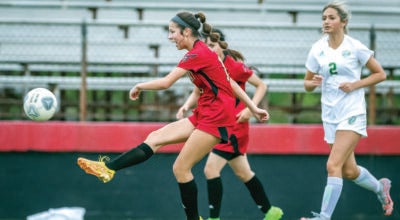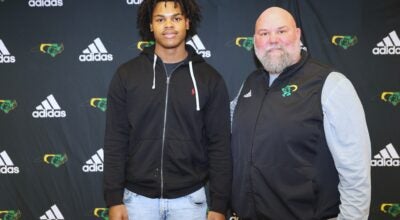Outdoors report: Dove season set to begin Monday
Published 12:00 am Tuesday, August 26, 2008
Dove season is set to open Monday at noon. Hunters scouting for birds are finding fair numbers in areas that had harvested crops or had been planted and prepared by mowing or plowing seed crops.
Wildlife officers will be investigating violations checking licenses and bag limits.
Baiting seems to be a problem each year, with some take the illegal approach of “sweetening” the field to have a good hunt. Bird seed, cracked corn, sunflower seeds, millet and whole corn are often used to attract birds. A few days before the season, a violator will plow the ground to hide the illegal bait.
An area is considered baited 10 days after the last seed is removed. Sometimes it’s dry weather or other factors that leave a poor yield. Then hunters may not be aware of illegal baiting in the area, especially if the ground has been plowed.
Before hunting, inspect the field by doing a walk through. Pay particular attention to areas where birds seem to concentrate. If you are in a mowed field where no crops have been planted and large numbers of dove are landing, you should ask yourself, “What is luring the doves to this field?”
Anyone convicted of taking dove by the aid of bait or over the limit can lose their hunting equipment (including guns, blinds and decoys), have their hunting privileges revoked for a minimum of one year, be fined a minimum of $150 in addition to court costs and have a class two misdemeanor put on their criminal record.
Equipment check
A simple check of equipment before opening day can save frustration, embarrassment and potential criminal charges.
– Look at your hunting license, especially the expiration date.
– Be sure you have the proper license that covers small game hunting.
– Check all shotguns that are capable of holding more than three shells for a proper “plug.” A pencil or stick is not a good choice. Try a wooden dow cut to size or a commercially made plug that fits your gun.
– Check your ammo, making sure you don’t have mixed gauge shells in the same bag or vest. Be sure that a buckshot shell has not been mixed in with your No. 8 shot. This can be a dangerous and eye opening surprise if you’re sitting on a small stool at an odd angle when a double 00 buckshot shell is shot at a dove by mistake.
– Don’t combine your limit of doves with another hunter. If a hunter is found with more than the limit of dove and doesn’t have a receipt showing the name, license information, date and number of birds given, the hunter could be charged with possession of over the limit.
Safety
Be aware of what is beyond your target. Shotgun shot may travel over 500 yards.
Although blaze orange is not required when dove hunting, it is important to know where other hunters are located before taking a shot.
Other important safety issues:
– Low birds can be hazardous to shoot at, so discuss this with other hunters.
– Unless a child has completed and passed a hunter education course, they must be under the immediate control of an adult while hunting. That does not mean sitting alone or with another child 50 yards away.
– Maintain muzzle control and keep your barrel pointed in a safe direction.
– Keep the gun’s safety on until an opportunity to fire occurs. After shooting, return it to safe.
Hunting areas
Game land dove fields in our area provide free access to anyone who has a small game hunting license, HIP certification and a game lands license. No other permits are required.
Other nearby areas include:
Perkins Game Land (Non Permit): From Mocksville travel U.S. 64 east for approximately 8 miles to N.C. 801. Turn right on N.C. 801 and travel 1.3 miles to Riverview Road (SR 1814). Turn left on Riverview Road and travel 0.1 mile to parking area/gate on right or continue 1.7 miles to a parking area at end of the paved road. Follow roads/trails on foot from parking areas to fields. Approximately 18 acres in four fields seeded to brown top and proso millet, buckwheat and corn. Drought has heavily impacted this year’s crops. The millet and buckwheat crops are only fair but should be mature by the first segment of dove season. The corn crop was near total failure and little opportunity for good hunting over this crop is expected during the second and third segments of the dove season.
Uwharrie Game Land (Non Permit): Favor Morris No. 1 (SR 1154). From Troy, travel approximately 10 miles north on Hwy 109. Approximately 1 mile after crossing the Uwharrie River, turn left on SR 1154 and continue 1 mile. Field on the right adjacent to road. Approximately 3 acres seeded to millet and/or wheat.
Favor Morris No. 2 (SR 1154). From Troy, travel approximately 10 miles north on Hwy 109. Approximately 1 mile after crossing the Uwharrie River, turn left on SR 1154 and continue 1 mile. Field is several hundred yards off road, behind the field on the road (trail on far end of first field leads to second). Approximately 2 acres seeded to millet and/or wheat.
Intersection (SR 1154/ Forest Service Rd 544). From Troy, travel approximately 10 miles north on Hwy 109. Approximately 1 mile after crossing the Uwharrie River, turn left on SR 1154 and continue approximately 1.5 miles to intersection of SR 1154 & USFS Road 544. Field on both sides of intersection. Approximately 3 acres seeded to millet and/or wheat.
Hedgerow (Forest Service Rd 544). From Troy, travel approximately 10 miles north on Hwy 109. Approximately 1 mile after crossing the Uwharrie River, turn left on SR 1154 and continue approximately 1.5 miles to intersection of SR 1154 and USFS Road 544. Turn left on USFS Road 544 and continue 0.25 mile. Field on left. Approximately 1 acre seeded to millet and/or wheat.
Turnip Patch (Forest Service Rd 576). From Troy, travel approximately 10 miles north on Hwy 109. Approximately 1 mile after crossing the Uwharrie River, turn left on SR 1154 and continue approximately 1.5 miles to intersection of SR 1154 & USFS Road 544. Turn left on USFS Road 544 and continue approximately 1 mile. Turn right on USFS Road 576. Field is approximately half a mile on left. Approximately 3 acres seeded to millet and/or wheat.
Thornburg No. 1 (SR 1107). From Asheboro, travel south on U.S. 49 approximately 5 miles to the community of Mechanic. Turn left on SR 1107 (Lassiter Mill Road). Continue approximately 2 miles. Field on left in front of old farm house. Approximately 6 acres seeded to millet and/or wheat.
Thornburg No. 1 (SR 1107). From Asheboro, travel south on U.S. 49 approximately 5 miles to the community of Mechanic. Turn left on SR 1107 (Lassiter Mill Road). Continue approximately 2 miles. Turn left into Thornburg Farm. Field approximately half a mile behind house. Follow path (foot travel only behind gate). Approximately 4 acres seeded to millet and/or wheat.
Sandhills Game Land (Non Permit): Field 1 (Parsons Tract). From Hoffman, travel northwest on SR 1003 (Derby Road) approximately 8 miles. Game land tract located on left. Approximately 30 acres seeded to annual mix of sunflower/sorghum/millet, corn, milo, and wheat.
Field 2 (Horse Creek Tract). From Pinebluff, travel south on US 1 approximately 2 miles. Turn right on SR 1102. Continue approximately a quarter of a mile, turn right on gravel road and follow signs to game lands and dove fields. Approximately 5 acres seeded to annual mixture of sorghum/millet, rye, and corn.
Field 3 (Steele Place). Field Trial Area; Special Regulations Apply. From Hoffman, travel northwest on SR 1003 (Derby Road) approximately 3 miles. Turn left on Field Trial Area & follow signs to dove fields. Approximately 4 acres seeded to corn, milo and millet.
Visit www.ncwildlife.org for more listings.
Wear life vests in canoes
In North Carolina, having a life vest for everyone on board a canoe or kayak is smart, potentially lifesaving ó and the law.
The N.C. Wildlife Resources Commission works to inform paddlers about an update to state regulations and officers are beginning enforcement on waterways. General Statute 15 NCAC 10F .0201 now requires that vessels be equipped with personal flotation devices.
The regulation previously stated “motorboat” and not “vessel,” which excluded canoes, kayaks and rowboats. All vessels are required to have at least one PFD (Type I, II or III) for each person on board. If the vessel is over 16 feet long, it is also required to have a throwable flotation device (Type IV PFD). The regulation update brings state law in line with existing federal regulations.
Any child younger than 13 is required to wear an appropriate life vest whenever they are on a recreational vessel that is under way. The life vest must be proper size and have a U.S. Coast Guard approved label.
Beach boating update
The N.C. Wildlife Resources Commission has purchased property next to its Sunset Harbor Boating Access Area to ensure adequate parking.
The purchase ó the first from the N.C. Waterfront Access and Marine Industry Fund ó will also allow renovations be made to the existing boat ramp on the Intracoastal Waterway.
The $915,000 grant, made possible through the General Assembly, will help protect waterfront access and preserve it for public use, according to Gordon Myers, deputy director.
The N.C. General Assembly approved $20 million in 2007 to pay for acquiring waterfront properties or developing facilities for waterfront access for the public.
E-mail Sgt. Anthony Sharum of the N.C. Wildlife Resources at huntfishguy66@aol.com.





